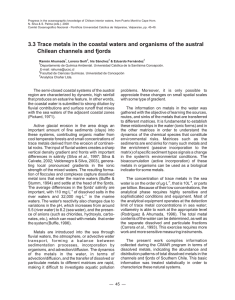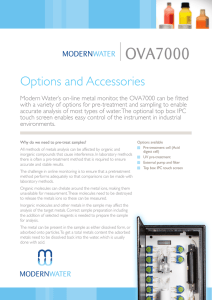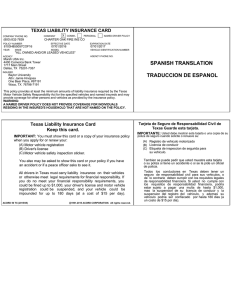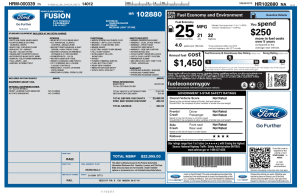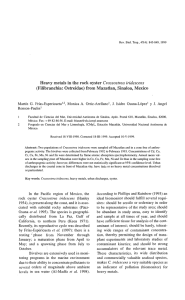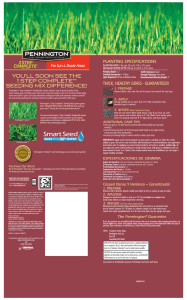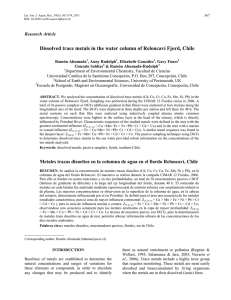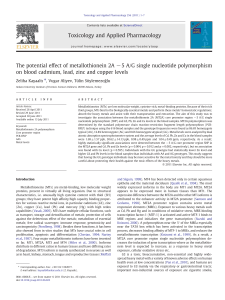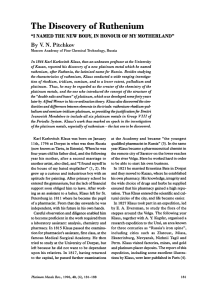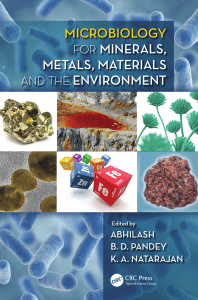Analysis of content of heavy metals in grass used to feed cattle by
Anuncio
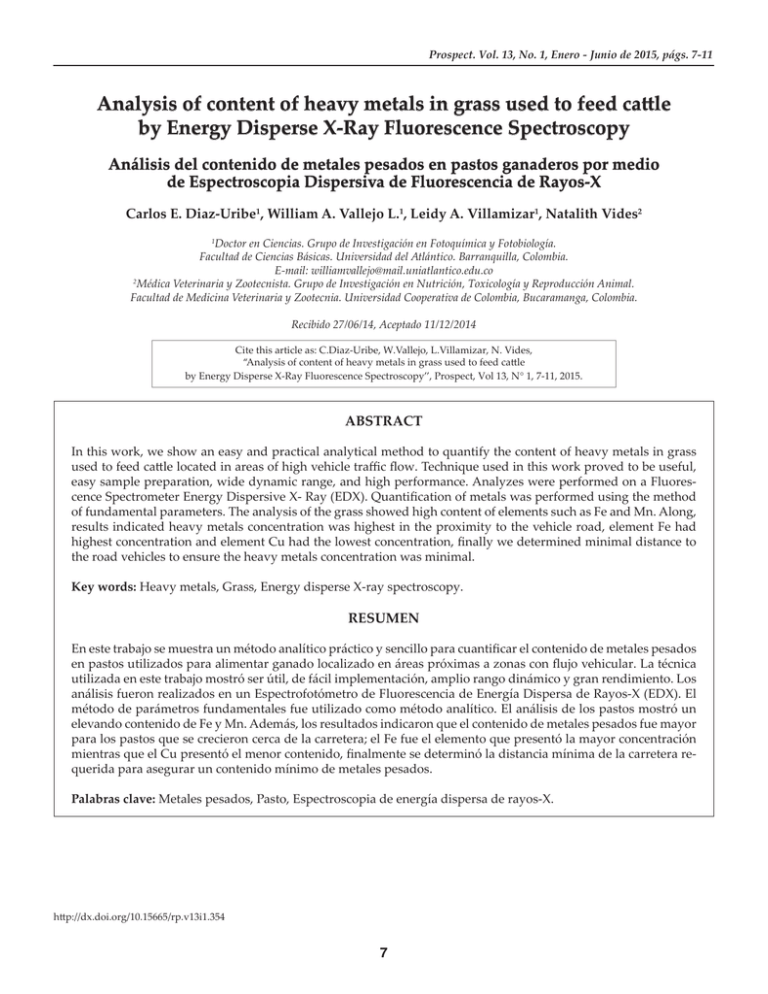
Prospect. Vol. 13, No. 1, Enero - Junio de 2015, págs. 7-11 Analysis of content of heavy metals in grass used to feed cattle by Energy Disperse X-Ray Fluorescence Spectroscopy Análisis del contenido de metales pesados en pastos ganaderos por medio de Espectroscopia Dispersiva de Fluorescencia de Rayos-X Carlos E. Diaz-Uribe1, William A. Vallejo L.1, Leidy A. Villamizar1, Natalith Vides2 Doctor en Ciencias. Grupo de Investigación en Fotoquímica y Fotobiología. Facultad de Ciencias Básicas. Universidad del Atlántico. Barranquilla, Colombia. E-mail: [email protected] 2 Médica Veterinaria y Zootecnista. Grupo de Investigación en Nutrición, Toxicología y Reproducción Animal. Facultad de Medicina Veterinaria y Zootecnia. Universidad Cooperativa de Colombia, Bucaramanga, Colombia. 1 Recibido 27/06/14, Aceptado 11/12/2014 Cite this article as: C.Diaz-Uribe, W.Vallejo, L.Villamizar, N. Vides, “Analysis of content of heavy metals in grass used to feed cattle by Energy Disperse X-Ray Fluorescence Spectroscopy”, Prospect, Vol 13, N° 1, 7-11, 2015. ABSTRACT In this work, we show an easy and practical analytical method to quantify the content of heavy metals in grass used to feed cattle located in areas of high vehicle traffic flow. Technique used in this work proved to be useful, easy sample preparation, wide dynamic range, and high performance. Analyzes were performed on a Fluorescence Spectrometer Energy Dispersive X- Ray (EDX). Quantification of metals was performed using the method of fundamental parameters. The analysis of the grass showed high content of elements such as Fe and Mn. Along, results indicated heavy metals concentration was highest in the proximity to the vehicle road, element Fe had highest concentration and element Cu had the lowest concentration, finally we determined minimal distance to the road vehicles to ensure the heavy metals concentration was minimal. Key words: Heavy metals, Grass, Energy disperse X-ray spectroscopy. RESUMEN En este trabajo se muestra un método analítico práctico y sencillo para cuantificar el contenido de metales pesados en pastos utilizados para alimentar ganado localizado en áreas próximas a zonas con flujo vehicular. La técnica utilizada en este trabajo mostró ser útil, de fácil implementación, amplio rango dinámico y gran rendimiento. Los análisis fueron realizados en un Espectrofotómetro de Fluorescencia de Energía Dispersa de Rayos-X (EDX). El método de parámetros fundamentales fue utilizado como método analítico. El análisis de los pastos mostró un elevando contenido de Fe y Mn. Además, los resultados indicaron que el contenido de metales pesados fue mayor para los pastos que se crecieron cerca de la carretera; el Fe fue el elemento que presentó la mayor concentración mientras que el Cu presentó el menor contenido, finalmente se determinó la distancia mínima de la carretera requerida para asegurar un contenido mínimo de metales pesados. Palabras clave: Metales pesados, Pasto, Espectroscopia de energía dispersa de rayos-X. http://dx.doi.org/10.15665/rp.v13i1.354 7 Analysis of content of heavy metals in grass used to feed cattle by Energy Disperse X-Ray Fluorescence Spectroscopy 1. INTRODUCTION 2. EXPERIMENTAL The analysis of heavy metals is an important issue for both the environmental sector and for public health sector due to when heavy metals are present in high concentrations in medium they cause adverse effects on animal health and, through the food chain, they can cause damage to public health [1]. Nowadays, the efforts try to minimize exposure of these toxic elements [2, 3]. The main representative heavy metals are lead, copper, zinc, cadmium, mercury, aluminum include, among others, which can be introduced into foods through industrial processes, fertilizers, irrigation process through polluted water and vehicular emissions [4-6]. Studies show that exposition to proximity to road vehicle emissions introduce large amounts of heavy metals into the environment in all phases like air, aquatic and solid atmosphere [7-9]. Currently in Colombia does not exist reports related to this kind of road pollution or about its environmental impact on the products used to feed animals. In Colombia and in many countries of Latin American is common to use grass located on the edge of roads with high vehicle traffic flow to feed cattle, however, these kinds of procedures do not involve the possible pollution of the grass due to vehicle emissions [10]. It is important the identification and quantification of contents heavy metals in this kind of food, due to high contents of heavy metals cause adverse effects on the cattle health and it could alter the quality of the products obtained from them like milk or meet. Konuspayeva et al. demonstrated that high concentrations of manganese and iron in are and milk are due to environmental pollution mainly by vehicle emissions [11]. Due to the importance of characterization of content of this elements in grass to support progress of production systems towards a sustainable and environmentally safety process to obtain safety products with the highest quality and contribute to food security in this work we determined Fe, Mn, Cu and Zn in grass located in high traffic areas and away from other anthropogenic sources such as industries or mining flow. Our interest is to determinate the real impact of the vehicle traffic emissions on the metal content of the surrounding grass used to feed the cattle of the zone. The convectional absorption atomic spectroscopy (AAS) is a typical analytical technic used to quantification of different metal in all kind of samples however is expensive and it requires strict experimental conditions [12]. In this work we replaced ASS by an easy and practical alternative technique named Energy Dispersive X-Ray Spectroscopy, which was shown to be a method that provides the desired characteristics: multielement capacity, easy sample preparation, wide dynamic range, high performance and lower implementation costs than AAS. 2.1 Location of the study zone This project was conducted in farms located in the village of the Quince in the township named Sabana de Torres located in Santander department of Colombia in South America. Sabana de Torres is located 110 km northwest of the provincial capital (Bucaramanga), with a temperature of 28.5 °C and an altitude of approximately 110 m above sea level (coordinate; 7°23′25″N 73°30′01″O). This land was selected because both it was located on the edge of the road vehicle and its extensive border with the vehicle road. Also, it is located away from other anthropogenic sources of external contamination like mines and industries. 2.2 Collection of samples We established twelve (12) points of collection of samples and, the total sampling area was 250 m long by 120 m wide, the location was selected to isolate the samples from other alternative sources of contaminants. After 40 days, the 12 points of collection were studied as follows: 4 points we studied vertically to the road with a distance of 40 meters between each point and by each vertical point we take 3 points horizontally with distance of 100 meters parallel to the road vehicle, in figure 1 is shown a scheme of the process of sampling. The grass was cut at height of 15 cm of appendix from leaf to the root; the weight of each sample was 120 grams. Finally the family of the grass of each sample was identified as Brachiaria humidicola, this specie of grass is native to tropical Africa, where it grows naturally in relatively moist areas and, it was introduced to America in 1965 from a collection of the University of Florida, along, Brachiaria is grass that is widespread in tropical American countries like Colombia [13]. Figure 1. General scheme for sampling process. Figura 1. Esquema general del proceso de muestreo. 8 Prospect. Vol. 13, No. 1, Enero - Junio de 2015, págs. 7-11 2.3 Sample analysis heavy metal and, we determined the percent coefficient of variation (% CV), defined as the percentage ratio between the standard deviation and the mean value. We determined the content (ppm) of four (4) elements presents in this type grass (Fe, Mn, Zn and Cu). First we reduce the size of the samples until 1.0 mm through a ball mill, the time milling was 10 minutes, after that, the powder was burn at 673K by 1 hour. The ashes were analyzed in the spectrometer X-ray fluorescence brand SHIMADZU EDX-800HS and, quantification of the content of the elements was performed using the method of Fundamental Parameters through the DXP software Version 1.00 Rel 700E-014 [14]. Each measurement of quantification of heavy metal content was repeated three times. 3. RESULTS According to the proposed methodology, in vertical direction, we took into account the four distances with a 40 meter intervals each one starting point “0” near the highway (see figure 1), ending at the fourth point located 120 meters away from the road; for horizontal samples we took three points identified by the letters “A, B, C” at a distance of 100 meters between points (see figure 1). In table 1 are listed the concentration of 4 metals for each point studied in this investigation, in table 2 are shown the data obtained in the statistics validation of the data showed in table 1. 2.4 Statistical analysis In analysis of the data recollected was performed a descriptive statistics (mean and standard deviation) for each Table 1. Metal concentration (ppm) to 4 heavy metals study in this work. Tabla 1. Concentración (ppm) de los cuatro (4) metales estudiados. Distance Location Fe Mn Zn Cu A 41,193± 0,231 34,881±0,205 17,360±0,035 5,120±0,023 0m B 48,576±0,567 32,032±0,422 19,920±0,067 4,484±0,042 C 41,124±0,338 40,117±0,289 16,241±0,072 4,320±0,021 A 33,534±0,179 19,866±0,087 11,760±0,025 3,120±0,014 B 27,945±0,234 19,096±0,326 8,485±0,082 2,565±0,077 40 m Concentration (ppm) C 32,568±0,596 23,023±0,106 8,722±0,098 2,487±0,056 A 19,803±0,128 15,246±0,137 7,920±0,017 1,224±0,003 B 19,596±0,205 16,023±0,144 6,402±0.054 1,041±0,006 C 19,234±0,325 14,476±0,231 7,288±0.104 0,961±0,063 A 19,251±0,088 13,937±0,031 6,321±0,021 1,362±0,011 120 m B 19,389±0,301 15,785±0,078 6,001±0,066 0,964±0,005 C 18,203±0,189 14,014±0,190 6,963±0,075 1,284±0,099 80 m Table 2. Pearson variation coefficient obtained to data listed in table1. Tabla 2. Variación del coeficiente de Pearson para los datos listados en la tabla 1. Fe Mn Zn Cu Test Distance (m) M SD %VC M SD % VC M SD % VC M SD % VC A (0) 43,63 4,28 9,8 35,68 4,1 11 18,08 2,6 14 4,64 0,42 9,1 B (40) 31,35 2,99 9,5 20,66 2,08 10 8,6 0,17 2 2,72 0,35 13 C (80) 18,63 1,86 10 15,48 1,42 9,2 6,8 1,42 21 1,08 0,13 13 D (120) 17,85 2,55 14 15,02 0,91 6,1 6,27 0,72 12 1,2 0,21 18 M: mean, SD: standard deviation, VC: Coefficient of Variance. 9 Analysis of content of heavy metals in grass used to feed cattle by Energy Disperse X-Ray Fluorescence Spectroscopy Figure 2. Content of each sample located in different point according to indications of figure 1: (a) Fe, (b) Mn, (c) Zn and (d) Cu. Figura 2. Contenido de cada muestra dependiendo de su ubicación de muestreo de la figura 1: (a) Fe, (b) Mn, (c) Zn y (d) Cu. (a) (b) (c) (d) Figure 2 shows the change of Fe concentration as the distance to the vehicle road change, it is clear that concentration of the Fe in the grass decrease when the distance to the vehicle road increases. These results suggest that in proximity to the road is present an effect of anthropogenic contamination of grass possibly due to vehicle emissions. Figure 2 shows that after 120 m the amount of Fe tends to be constant near to 19-20 ppm, it indicates under specific atmospheric condition of the zone, after 120 m of distance to the road, the vehicle emissions are absorbed by grass and the content of Fe decrease greatly. Similar tendency were found to others heavy metals, figure 3, 4 and 5 show the change of contents of Mn, Zn and Cu respectively as the distance to the vehicle road change, in the same way to Fe concentration, for this three metals their concentration in the grass decrease when the distance to the vehicle 10 Prospect. Vol. 13, No. 1, Enero - Junio de 2015, págs. 7-11 tion of Camel Milk (Heavy Metals, Organic Pollutants and Radionuclides)”, Journal of Environmental Protection, 2, 90-96, 2011. road increases and, after 120 m the amount of Mn in the grass tends to be constant near to 14 ppm, the amount of Zn in the grass tends to be constant near to 7 ppm and the amount of Cu in the grass tends to be constant near to 1.1 ppm. These results indicate the amount of metal concentration in the grass depends on distance to the road, in all cases the metal concentration increases when the sample is closer to the vehicle road. These results suggest that the grass is could pollute due to emissions generated by the vehicles travel through the vehicle road. These highs contents of heavy metal could alter the physicochemical properties of milk obtained from the cattle. Our results indicated that under typical conditions of the location the best place to build a cowshed to herd cattle is located to a minimal distance of the 120 m of the vehicle road to ensure the minimal anthropogenic pollution of the grass caused by vehicle emission. This results is significantly, this practical technic could be used as tool to establish political of design of farms and cowshed used as source of food to being. [4] T. A. Laniyan, K. Phillips, L. Elesha, “Hazards of heavy metal contamination on the groundwater around a municipal dumpsite in Lagos, Southwestern Nigeria”, International Journal of Engineering & Technology, 11, 61-69. 2011. [5] T.M. Minkina, G.V. Motuzova, S. Mandzhieva, O.G. Nazarenko, “Ecological resistance of the soil-plant system to contamination by heavy metals”, Journal of Geochemical Exploration, 123, 33-40, 2012. [6] Y. Tao, L. Qingsheng, Li. Haixia, Q. Zeng, C. Lungsang, “Anthropogenic magnetic particles and heavy metals in the road dust: Magnetic identification and its implications”, Atmospheric Environment, 44, 1175-1185, 2010. [7] W. Ya-Fen, H. Kuo-Lin, L. Chun-The, M. Hsiao.Hsuan, “Emissions of fuel metals content from a diesel vehicle engine”, Atmospheric Environment, 37, 4637-4643, 2003. 4. CONCLUSIONS We determined the content of Fe, Mn, Zn and Cu in samples of grass located proximity to the vehicle traffic road. We replaced the AAS a typical analytical method by fluorescence energy dispersive X-ray. The analysis of the feed showed high concentration of elements such as iron, manganese, zinc and copper. Results indicated a high pollution of the grass in proximity to the vehicle traffic road to all elements studied and, they show that after 120 meters of distance the content of the metals is stable and minimal. Along, the statistic of the data permitted to validate our experimental results. Our results permitted to establish parameters of control to farm building to decrease the contamination of animals involve in food chain, it decrease its negative impact to public health. Finally, the analytical technic used in this work proved to be useful, easy sample preparation, wide dynamic range, and high performance to study samples of agriculture. [8] K. Ulrike, P. Jozef, F. Rainer, “Assessment of heavy metal releases from the use phase of road transport in Europe”, Atmospheric Environment, 43, 640-647, 2009. [9] X. Li, L. Liu, Y. Wang, G. Luo, X. Chen, X. Yang, M. Hall, R. Guo, H. Wang, J. Cui, X. He, “Heavy metal contamination of urban soil in an old industrial city (Shenyang) in Northeast China”, Geoderma, 192, 50-58, 2013. [10] D. Trang, L. Byeong-Kyu, “Determining contamination level of heavy metals in road dust from busy traffic areas with different characteristics”, Journal of Environmental Management, 92, 554-562, 2011. [11] G. Konuspayeva, B. Faye, G. Loiseau, E. Diacono, S. Akhmetsadykova, “Pollution of Camel Milk by Heavy Metals in Kazakhstan”, The Open Environmental Pollution & Toxicology Journal, 2, 112-118, 2009. REFERENCES [12] M. Tüzen, “Determination of heavy metals in fish samples of the middle Black Sea (Turkey) by graphite furnace atomic absorption spectrometry”, Food Chemistry, 80, 119-123, 2003. [1] H. Wang, Y. Dong, Y. Yang, S. Gurpal, X. Zhang. “Changes in heavy metal contents in animal feeds and manures in an intensive animal production region of China”, Journal of Environmental, 25, 2435-2442, 2013. [2] H. Ko, K. Kim, T. Hyeon, K. N. Chi, K. Kim, “Umeda. Evaluation of maturity parameters and heavy metal contents in composts made from animal manure”, Waste Management, 28, 813-820, 2008. [13] R. González, Y. Newman, “Response of Brachiaria Humidicola pasture to nitrogen, phophorus and potassium fertilization on “Sabanas de la Villa” soils (Tropical Dry Forest)”, Revista de la Facultad de Agronomía (LUZ), 12, 331341, 1995. [3] G. Konuspayeva, S. Jurjanz, G. Loiseau, V. Barci, S. Akhmetsadykova, A. A. Meldebekova, B. Faye, “Contamina- [14] D. Harris, Quantitative Chemical Analysis. New York, Unites States, W. H. Freeman and Company Editors, 2006, pp. 455. 11
